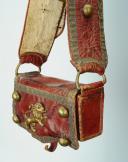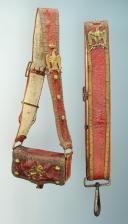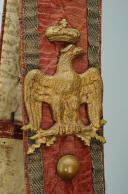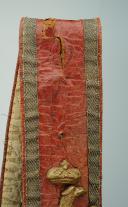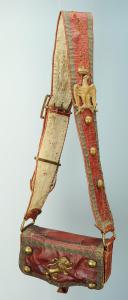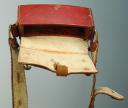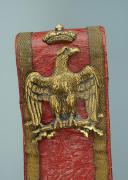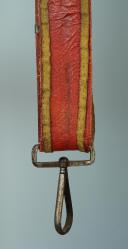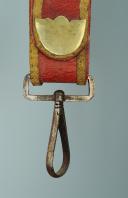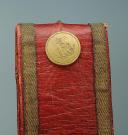
SET OF CARTRIDGE BOX AND BANDOLEER FOR THE MOUNTED NATIONAL GUARD OF LYON, FIRST EMPIRE.
Sold out
SABRETACHE AND BANDOLIER WITH CARABINER HOLDER OF THE NATIONAL GUARD ON HORSEBACK FROM LYON, FIRST EMPIRE.
SABRETACHE:
Sabretache or "cartridge belt" in wood covered with Bordeaux waxed calf leather.
Small leather flap, rectangular cut in a bracket shape, measuring 183 mm in width at the bottom, and 172 mm at the top, with a height of 96 mm; background in Bordeaux waxed morocco leather, with the outer edge folded inward. The flap is framed by a 10 mm wide gold braid that outlines the edges, with a half-spherical gilt brass uniform button (diameter 18 mm) fixed in each corner, and a molded brass lion mounted in the center, chiseled and gilt (56 mm in width, 51 mm in height, and approximately 7 mm thick). It is lined with white calf leather. A Bordeaux waxed leather strap is sewn at the bottom to close the flap.
The cartridge holder, a large wooden box made of beech wood, measures 60 mm in height, 174 mm in width, and 43.5 mm in depth. The sides are also made of wood covered with Bordeaux waxed morocco leather, with an iron nail fixed under the cartridge to keep the strap of the flap closed.
Gilt brass bandolier hook.
Bandolier made of leather covered with Bordeaux waxed morocco leather and lined with white calf leather. It is edged with a gold braid on each side (10 mm wide) and adorned in the center with a series of gilt brass half-spherical uniform buttons like on the flap, with only three of the original ten buttons remaining in place. The bandolier is decorated with a beautiful imperial eagle topped with a crown, both elements made entirely of molded brass finely chiseled and gilted with mercury. Eagle: height 82 mm, width 65 mm, thickness approximately 8 mm. Imperial crown: height 16 mm, width 25.5 mm, thickness approximately 8 mm. Other fittings of the bandolier, also gilt brass and polished with agate stone: a badge ending the bandolier, a clip for fastening the bandolier, and a buckle with hook for adjusting the bandolier length.
Bandolier width 62 mm.
CARABINER HOLDER:
Bandolier made of leather covered with Bordeaux waxed morocco leather and lined with white calf leather, edged with a gold braid on each side (10 mm wide). In the upper part, a flat brass carabiner button with an engraved face of an imperial eagle is attached. The bandolier is decorated with a beautiful imperial eagle topped with a crown, both elements made entirely of molded brass finely chiseled and gilded with mercury. Eagle: height 82 mm, width 65 mm, thickness approximately 8 mm. Imperial crown: height 16 mm, width 25.5 mm, thickness approximately 8 mm. Other fittings of the bandolier, also gilt brass and polished with agate stone: a badge ending the bandolier, a clip for fastening the bandolier, and a buckle with hook for adjusting the bandolier length.
A sturdy iron hook (height 113 mm, width 44 mm, thickness 11 mm) for attaching the carabiner is riveted to a rectangular iron ring (height 34.5 mm, width 90 mm, thickness 5.5 mm).
Bandolier width 70 mm.
Very good condition.
This set is particularly interesting as these two elements share the same patina and are perfectly original.
First Empire, 1804-1814.
HISTORICAL INFORMATION:
HISTORICAL BACKGROUND BY JÉRÔME CROYET: http://www.histoire-empire.org/historiques_de_regiments/gardes_honneur_lyon.htm
From 1802 to 1814, Napoleon's travels and visits within the Empire were occasions for grand events and displays of splendor and communication devices. During imperial movements, gatherings of young people who took on the duty of ensuring the protection of imperial figures during their visits and providing an escort were often formed under the name "Gardes d'honneur." These could be at the communal or departmental level, estimated at around 174 in total.
The Lyon Guard sets itself as the first to have been formed, as Lyon aims to be the first city of the Empire: "Lyon is the first city where an honor guard was formed; thus, this guard is the 1st of the Empire."
The beginnings of a prestigious regiment: the visit of the First Consul in 1802.
During the first official trip of Consul Bonaparte to Lyon, from 21 nivôse to 7 pluviôse in year X, to oversee the deliberations of the Cisalpine deputies on their Constitution, the Lyon Honorary Guard was formed. This group, composed of the "brilliant Lyon youth," forming the social elite of the Lyonnais, established itself as an autonomous light cavalry unit. The guards were responsible for paying for their uniforms, equipment, and horses. To honor the Consul and provide an acceptable service to him, the young men engaged in equestrian maneuvers. Their uniform consisted of a tailcoat, Hungarian breeches, a hat, and a saber typical of light cavalry of the Guard.
Endowed with a flag that distinguished it from the National Guard, the Lyon Honor Guard prepared, from the 19th nivôse, for the arrival of the "restorer of the nation." For two days, as Napoleon made his way to Mâcon, the Honor Guard awaited the arrival of the august figure to accompany him, preceding the imperial convoy. During this consular stay, the Lyon Honor Guard drew closer to the Consular Guard, not only through their joint service to Bonaparte but also through a meal offered by the former to the latter.
Bonaparte was impressed by the military attire and service of these young Lyonnais. From his second trip to Brittany onwards, he used Lyon as a benchmark for judging the reception of a city: "I am as pleased with Rouen as with Lyon. This city shows me signs of attachment that touch me," he wrote to his brother Joseph on November 2, 1802.
Essentially a desire for splendor and demonstration on the part of the Lyonnais, the Lyon Honor Guard, despite Bonaparte’s departure, remained active, which the government approved through a circular on the 2nd complementary day of Year XI.
The Lyon Honor Guard: splendor and communication tools of the city
Eager to demonstrate their attachment to an impressed Napoleon during his visit to Lyon, the "young men" of Lyon expressed the desire to maintain the Honor Guard permanently. This transformation of the Lyon Honor Guard, desired by the Minister of the Interior, gained momentum with Napoleon's coronation as Emperor.
From the 23rd ventôse in Year XIII, General Duhesme provided the cost estimates for transforming the Lyon Honor Guard into "His Majesty the Emperor's Honor Guard." The next day, the municipality, wanting to assist the "young men" of Lyon, made available to the head of the Honor Guard a sum of 5,000 francs, 3000 francs from the town hall and 2000 francs from the prefecture, to help the volunteers finance their uniforms.
In response to the Lyonnais' desire to establish a truly organized corps, a military and communicative showcase for the city, on the 15th germinal in Year XIII, the Lyon City Council decided to reorganize its Honor Guard. For effective reform, the military authority's cooperation was sought, resulting in the formation of a foot company with two companies and a horse company within the Guard. The military authority mandated that the Honor Guards must be born in Lyon and willingly serve as escorts to Napoleon during his visits and stays (Lyon was one of the four cities set to host an imperial palace). While this service was a mark of Lyon's dedication to the imperial cause and, more importantly, an attachment to Napoleon's physical presence, it was also crucial for the city's future and its reputation in Europe: "There is none in the entire Empire where the Emperor has received such prominent and repeated marks of devotion."
From a company on horseback of 100 to 150 men in 1802, the Lyon Honor Guard evolved into a true corps consisting of a company of foot chasseurs, a company of grenadiers, and a company on horseback, totaling 231 men. The command was entrusted to a general, assisted by a colonel working in the imperial administration, which transferred part of the Guard's aura to the latter.
To give grandeur, luster, and a well-structured appearance to the Honor Guard, the municipality accepted the formation of a voluntary corps of musicians attached to the staff, funded at its own cost.
A sustainable setup under the approving eye of Paris
The reorganization of the Lyon Honor Guard was approved in Paris through official control requests. However, these controls took time to reach the capital, revealing the Guard's shortcomings: the seriousness and assiduity of the officers. On November 14th in Year XIV, the surprised Minister, for not having received the control, requested it again from the Prefect of Rhône, who then transmitted it to the Mayor, informing the General of the Honor Guard on the 17th. These problems persisted for several years. On December 4, 1808, the officers of the grenadiers and chasseurs of the Lyon Honor Guard could not agree on the dress code for maneuvers: some arrived "with only their sabers, while others brought their weapons." On December 5th, 26 "members of the imperial Honor Guard" on foot in Lyon complained to the Mayor about the officers' absenteeism during ceremonies, or the lack of orientation and contradictory orders, demanding that the officers comply with the regulations.
Nevertheless, the prestige of the Lyon Honor Guard, which refused to be assimilated with the National Guard, was such that when the Prefect of Rhône appointed deputies from the latter to travel to Paris to pledge their allegiance on the day of the coronation, he designated only fourteen men out of the requested eighteen, leaving room for three deputies from the Lyon Honor Guard. Conscious of their position, these three took advantage of their trip to ask the Minister to exempt three Honor Guards from conscription to accompany the Emperor.
Seeking to prepare for the imperial reception in Lyon and to make the most of the Lyon Honor Guard, the Minister of the Interior, on the 1st vendémiaire in Year XIV, asked the Prefect of Rhône and the Mayor of Lyon to coordinate the Honor Guard's service. This service was crucial for Napoleon. While generally, the "central government overlooked the Honor Guards," it specifically made an effort to be concerned about that of Lyon, not regarding it as just any other unit with "ephemeral duties."
While the government emphasized the Honor Guards' obligation to pay for their uniforms and equipment, as early as Year XIV, the Lyon Honor Guard was partially funded by the city and the prefecture. The Honor Guard's Administration Council reported on its accounts to the Mayor: on the 12th frimaire in Year XIV, the city financed the purchase of weapons for the Lyon Honor Guard's infantry. Until 1811, the city was authorized by the prefecture to deduct part of the budget reserved for festivities to fund the Honor Guard.
Now under the Emperor's benevolence, the Lyon Honor Guard, as the government shifted honors responsibilities to the elite of the National Guard, received an emblem blessed by Pope Pius VII and a regulation. The regulation, partially published in 1807, described the uniform and mandated morning exercises at 6:30 am at the St. Pierre building and regular inspections.
The Lyon Honor Guard and the imperial Honor Guard in Year XIV: a precursor to the 1813 Guard
The government's desire for the Lyon Honor Guard to become a militarized unit coincided with preparations for the 1805 campaign. Following spontaneous requests from individuals to voluntarily join Napoleon, "in the autumn of 1805, the government tried to transform these local Honor Guards into a military unit." Lyon was one of the first cities to send such requests, much to the satisfaction of the Minister of the Interior, who lauded the Lyonese enthusiasm: "The expectations I had placed on the feelings of the Lyon residents and their devotion to His Majesty have not been deceived," he wrote on the 20th vendémiaire in Year XIV. These Lyonese Honor Guards volunteers numbered 13: 4 grenadiers and 9 chasseurs. With an average age of 19 and a half, they were mostly from the Lyon petty bourgeoisie. To stimulate Lyon's ardor and demonstrate imperial gratitude to an important city in Napoleon's political network, the Minister granted a few privileges to these volunteers: the recruits of Year XV were allowed to accompany the Emperor, while those of Year XIV were required to find replacements.
Since the creation of the gendarmes d'ordonnance, the central administration considered the Lyon Honor Guard as a recruiting pool for prestigious units. On November 6, 1806, in an attempt to attract Lyonese to these services, the Minister promised to cover the city's costs for the horses of the first 8 Lyon Honor Guardsmen to depart. This call was well-received, with 6 guards departing. In 1813, the same sentiment of drawing from a resource pool for the formation of new Honor Guards existed, albeit with mixed results.
Henceforth, the Lyon Honor Guard held a high regard for its military function and the role its members played in the imperial army. They envisioned bridging a gap with the Imperial Guard, particularly with the prestigious Chasseurs à Cheval.
The Mounted Honor Guard
The publication of the 1807 regulation matched the revival and reorganization of the mounted Lyon Honor Guard. Until September 15, 1808, the Lyon mounted Honor Guard remained inactive, supporting the foot Honor Guard: there were few members, not enough for active service due to the high expenses of keeping a horse in the city. This especially puzzled the Management Committee of the mounted company, particularly because no other cavalry corps in other cities surpassed them, "causing profound discouragement." On September 15, 1808, the Management Committee of the mounted chasseurs of the Lyon Honor Guard proposed a means to increase the company to the Lyon municipality: the city should take care of the forage and lodging for the 60 horses that the mounted chasseur company of the Lyon Honor Guard would have. If the municipality agreed to this arrangement, the Management Committee asserted that over 25 people were ready to dress, arm, and equip themselves at their expense, ensuring to acquire suitable cavalry-type horses from Normandy. The committee also undertook, in case of acceptance, to bear the salary and subsistence of grooms and riding instructors. On February 2, 1809, the squadron commander reiterated the request for stables and forage to the Mayor. However, it appeared that the city was now obliged to follow central directives to no longer financially support the Honor Guards.
Despite the lack of response from the municipality, the mounted chasseurs of the Lyon Honor Guard reorganized on September 27, 1807: 126 Lyon residents volunteered. Two-thirds were young men living with their parents, while the remaining third were from artisan backgrounds.
On October 13, 1808, the Management Committee of the mounted Honor Guard asked the Lyon Mayor for permission to incorporate a Lyon surgeon who wished to serve as a chief surgeon major. In 1811, the three trumpeters of the mounted company of the Lyon Honor Guard received new uniforms paid for by the city, which, to preempt the prefecture's objection, claimed they served both the Honor Guard and the National Guard. In 1813, the mounted chasseurs of the Lyon Honor Guard, like the entire unit, still hoped to play a role. On September 20, the Lyon City Hall received the bill for the uniforms of the three trumpeters of the mounted company as the three men left for the army.
Establishment of a prestigious corps
In 1809, a major review of the mounted Lyon Honor Guard was conducted, consisting of a company of grenadiers, with fluctuating numbers, a company of foot chasseurs, and a company of mounted chasseurs. The music, previously entrusted to amateurs, was disbanded on February 19, 1809, and replaced by 21 paid musicians, as in line regiments. The band included a conductor, a teacher, two bassoons, a bass drum, four clarinets, three piccolos, three cymbal players, three Chinese hats, a flute, a trombone, a trumpet, a serpent, and two horns. Paid 3,995 francs annually, these 21 musicians, mostly teachers, elevated the Honor Guard's prestige, despite problems arising from the musicians' livelihoods. Given that the musicians made a living from music, they couldn't devote all their time to the Honor Guard's music. To earn a living, they played on Sundays in processions or during Te Deums, but as members of the Honor Guard, they needed official dispensations from the city to perform.
In 1810, a review of the mounted Honor Guard was sent to Paris, coinciding with the government's circular of July 30, 1810, demonstrating its interest in making these formations official henceforth.
As the 4th regiment of Honor Guards began in 1813, the Lyon Honor Guard experienced a final surge when General Valence planned to reorganize them into a single unit. A review of the 1813 chasseur company took place, consisting of 77 members. The average age was much higher than in 1805: 28 years. These Honor Guards were primarily men from Lyon's artisan and merchant classes: 44 merchants, traders, and businessmen, with only one landowner. They also included former military personnel, seven of whom were there in 1805. This Lyon Honor Guard focused more on Lyon than the earlier one did. From July 30, 1810, Honor Guards became official formations, and the Lyon Honor Guard was no exception. The presence of two former federalist combatants from the Lyon siege, who were also the two poorest guards, underscored the historical and cultural connection between the Honor Guard and the city of Lyon.
This surge marked the swan song of the prestigious Lyon Honor Guard, even though it still appeared in directories in 1814: on September 20, 1813, Commander de Cuzieu of the chasseur company handed the company's standard to the Lyon Mayor as he left the city with the 4th regiment of Honor Guards.
SABRETACHE:
Sabretache or "cartridge belt" in wood covered with Bordeaux waxed calf leather.
Small leather flap, rectangular cut in a bracket shape, measuring 183 mm in width at the bottom, and 172 mm at the top, with a height of 96 mm; background in Bordeaux waxed morocco leather, with the outer edge folded inward. The flap is framed by a 10 mm wide gold braid that outlines the edges, with a half-spherical gilt brass uniform button (diameter 18 mm) fixed in each corner, and a molded brass lion mounted in the center, chiseled and gilt (56 mm in width, 51 mm in height, and approximately 7 mm thick). It is lined with white calf leather. A Bordeaux waxed leather strap is sewn at the bottom to close the flap.
The cartridge holder, a large wooden box made of beech wood, measures 60 mm in height, 174 mm in width, and 43.5 mm in depth. The sides are also made of wood covered with Bordeaux waxed morocco leather, with an iron nail fixed under the cartridge to keep the strap of the flap closed.
Gilt brass bandolier hook.
Bandolier made of leather covered with Bordeaux waxed morocco leather and lined with white calf leather. It is edged with a gold braid on each side (10 mm wide) and adorned in the center with a series of gilt brass half-spherical uniform buttons like on the flap, with only three of the original ten buttons remaining in place. The bandolier is decorated with a beautiful imperial eagle topped with a crown, both elements made entirely of molded brass finely chiseled and gilted with mercury. Eagle: height 82 mm, width 65 mm, thickness approximately 8 mm. Imperial crown: height 16 mm, width 25.5 mm, thickness approximately 8 mm. Other fittings of the bandolier, also gilt brass and polished with agate stone: a badge ending the bandolier, a clip for fastening the bandolier, and a buckle with hook for adjusting the bandolier length.
Bandolier width 62 mm.
CARABINER HOLDER:
Bandolier made of leather covered with Bordeaux waxed morocco leather and lined with white calf leather, edged with a gold braid on each side (10 mm wide). In the upper part, a flat brass carabiner button with an engraved face of an imperial eagle is attached. The bandolier is decorated with a beautiful imperial eagle topped with a crown, both elements made entirely of molded brass finely chiseled and gilded with mercury. Eagle: height 82 mm, width 65 mm, thickness approximately 8 mm. Imperial crown: height 16 mm, width 25.5 mm, thickness approximately 8 mm. Other fittings of the bandolier, also gilt brass and polished with agate stone: a badge ending the bandolier, a clip for fastening the bandolier, and a buckle with hook for adjusting the bandolier length.
A sturdy iron hook (height 113 mm, width 44 mm, thickness 11 mm) for attaching the carabiner is riveted to a rectangular iron ring (height 34.5 mm, width 90 mm, thickness 5.5 mm).
Bandolier width 70 mm.
Very good condition.
This set is particularly interesting as these two elements share the same patina and are perfectly original.
First Empire, 1804-1814.
HISTORICAL INFORMATION:
HISTORICAL BACKGROUND BY JÉRÔME CROYET: http://www.histoire-empire.org/historiques_de_regiments/gardes_honneur_lyon.htm
From 1802 to 1814, Napoleon's travels and visits within the Empire were occasions for grand events and displays of splendor and communication devices. During imperial movements, gatherings of young people who took on the duty of ensuring the protection of imperial figures during their visits and providing an escort were often formed under the name "Gardes d'honneur." These could be at the communal or departmental level, estimated at around 174 in total.
The Lyon Guard sets itself as the first to have been formed, as Lyon aims to be the first city of the Empire: "Lyon is the first city where an honor guard was formed; thus, this guard is the 1st of the Empire."
The beginnings of a prestigious regiment: the visit of the First Consul in 1802.
During the first official trip of Consul Bonaparte to Lyon, from 21 nivôse to 7 pluviôse in year X, to oversee the deliberations of the Cisalpine deputies on their Constitution, the Lyon Honorary Guard was formed. This group, composed of the "brilliant Lyon youth," forming the social elite of the Lyonnais, established itself as an autonomous light cavalry unit. The guards were responsible for paying for their uniforms, equipment, and horses. To honor the Consul and provide an acceptable service to him, the young men engaged in equestrian maneuvers. Their uniform consisted of a tailcoat, Hungarian breeches, a hat, and a saber typical of light cavalry of the Guard.
Endowed with a flag that distinguished it from the National Guard, the Lyon Honor Guard prepared, from the 19th nivôse, for the arrival of the "restorer of the nation." For two days, as Napoleon made his way to Mâcon, the Honor Guard awaited the arrival of the august figure to accompany him, preceding the imperial convoy. During this consular stay, the Lyon Honor Guard drew closer to the Consular Guard, not only through their joint service to Bonaparte but also through a meal offered by the former to the latter.
Bonaparte was impressed by the military attire and service of these young Lyonnais. From his second trip to Brittany onwards, he used Lyon as a benchmark for judging the reception of a city: "I am as pleased with Rouen as with Lyon. This city shows me signs of attachment that touch me," he wrote to his brother Joseph on November 2, 1802.
Essentially a desire for splendor and demonstration on the part of the Lyonnais, the Lyon Honor Guard, despite Bonaparte’s departure, remained active, which the government approved through a circular on the 2nd complementary day of Year XI.
The Lyon Honor Guard: splendor and communication tools of the city
Eager to demonstrate their attachment to an impressed Napoleon during his visit to Lyon, the "young men" of Lyon expressed the desire to maintain the Honor Guard permanently. This transformation of the Lyon Honor Guard, desired by the Minister of the Interior, gained momentum with Napoleon's coronation as Emperor.
From the 23rd ventôse in Year XIII, General Duhesme provided the cost estimates for transforming the Lyon Honor Guard into "His Majesty the Emperor's Honor Guard." The next day, the municipality, wanting to assist the "young men" of Lyon, made available to the head of the Honor Guard a sum of 5,000 francs, 3000 francs from the town hall and 2000 francs from the prefecture, to help the volunteers finance their uniforms.
In response to the Lyonnais' desire to establish a truly organized corps, a military and communicative showcase for the city, on the 15th germinal in Year XIII, the Lyon City Council decided to reorganize its Honor Guard. For effective reform, the military authority's cooperation was sought, resulting in the formation of a foot company with two companies and a horse company within the Guard. The military authority mandated that the Honor Guards must be born in Lyon and willingly serve as escorts to Napoleon during his visits and stays (Lyon was one of the four cities set to host an imperial palace). While this service was a mark of Lyon's dedication to the imperial cause and, more importantly, an attachment to Napoleon's physical presence, it was also crucial for the city's future and its reputation in Europe: "There is none in the entire Empire where the Emperor has received such prominent and repeated marks of devotion."
From a company on horseback of 100 to 150 men in 1802, the Lyon Honor Guard evolved into a true corps consisting of a company of foot chasseurs, a company of grenadiers, and a company on horseback, totaling 231 men. The command was entrusted to a general, assisted by a colonel working in the imperial administration, which transferred part of the Guard's aura to the latter.
To give grandeur, luster, and a well-structured appearance to the Honor Guard, the municipality accepted the formation of a voluntary corps of musicians attached to the staff, funded at its own cost.
A sustainable setup under the approving eye of Paris
The reorganization of the Lyon Honor Guard was approved in Paris through official control requests. However, these controls took time to reach the capital, revealing the Guard's shortcomings: the seriousness and assiduity of the officers. On November 14th in Year XIV, the surprised Minister, for not having received the control, requested it again from the Prefect of Rhône, who then transmitted it to the Mayor, informing the General of the Honor Guard on the 17th. These problems persisted for several years. On December 4, 1808, the officers of the grenadiers and chasseurs of the Lyon Honor Guard could not agree on the dress code for maneuvers: some arrived "with only their sabers, while others brought their weapons." On December 5th, 26 "members of the imperial Honor Guard" on foot in Lyon complained to the Mayor about the officers' absenteeism during ceremonies, or the lack of orientation and contradictory orders, demanding that the officers comply with the regulations.
Nevertheless, the prestige of the Lyon Honor Guard, which refused to be assimilated with the National Guard, was such that when the Prefect of Rhône appointed deputies from the latter to travel to Paris to pledge their allegiance on the day of the coronation, he designated only fourteen men out of the requested eighteen, leaving room for three deputies from the Lyon Honor Guard. Conscious of their position, these three took advantage of their trip to ask the Minister to exempt three Honor Guards from conscription to accompany the Emperor.
Seeking to prepare for the imperial reception in Lyon and to make the most of the Lyon Honor Guard, the Minister of the Interior, on the 1st vendémiaire in Year XIV, asked the Prefect of Rhône and the Mayor of Lyon to coordinate the Honor Guard's service. This service was crucial for Napoleon. While generally, the "central government overlooked the Honor Guards," it specifically made an effort to be concerned about that of Lyon, not regarding it as just any other unit with "ephemeral duties."
While the government emphasized the Honor Guards' obligation to pay for their uniforms and equipment, as early as Year XIV, the Lyon Honor Guard was partially funded by the city and the prefecture. The Honor Guard's Administration Council reported on its accounts to the Mayor: on the 12th frimaire in Year XIV, the city financed the purchase of weapons for the Lyon Honor Guard's infantry. Until 1811, the city was authorized by the prefecture to deduct part of the budget reserved for festivities to fund the Honor Guard.
Now under the Emperor's benevolence, the Lyon Honor Guard, as the government shifted honors responsibilities to the elite of the National Guard, received an emblem blessed by Pope Pius VII and a regulation. The regulation, partially published in 1807, described the uniform and mandated morning exercises at 6:30 am at the St. Pierre building and regular inspections.
The Lyon Honor Guard and the imperial Honor Guard in Year XIV: a precursor to the 1813 Guard
The government's desire for the Lyon Honor Guard to become a militarized unit coincided with preparations for the 1805 campaign. Following spontaneous requests from individuals to voluntarily join Napoleon, "in the autumn of 1805, the government tried to transform these local Honor Guards into a military unit." Lyon was one of the first cities to send such requests, much to the satisfaction of the Minister of the Interior, who lauded the Lyonese enthusiasm: "The expectations I had placed on the feelings of the Lyon residents and their devotion to His Majesty have not been deceived," he wrote on the 20th vendémiaire in Year XIV. These Lyonese Honor Guards volunteers numbered 13: 4 grenadiers and 9 chasseurs. With an average age of 19 and a half, they were mostly from the Lyon petty bourgeoisie. To stimulate Lyon's ardor and demonstrate imperial gratitude to an important city in Napoleon's political network, the Minister granted a few privileges to these volunteers: the recruits of Year XV were allowed to accompany the Emperor, while those of Year XIV were required to find replacements.
Since the creation of the gendarmes d'ordonnance, the central administration considered the Lyon Honor Guard as a recruiting pool for prestigious units. On November 6, 1806, in an attempt to attract Lyonese to these services, the Minister promised to cover the city's costs for the horses of the first 8 Lyon Honor Guardsmen to depart. This call was well-received, with 6 guards departing. In 1813, the same sentiment of drawing from a resource pool for the formation of new Honor Guards existed, albeit with mixed results.
Henceforth, the Lyon Honor Guard held a high regard for its military function and the role its members played in the imperial army. They envisioned bridging a gap with the Imperial Guard, particularly with the prestigious Chasseurs à Cheval.
The Mounted Honor Guard
The publication of the 1807 regulation matched the revival and reorganization of the mounted Lyon Honor Guard. Until September 15, 1808, the Lyon mounted Honor Guard remained inactive, supporting the foot Honor Guard: there were few members, not enough for active service due to the high expenses of keeping a horse in the city. This especially puzzled the Management Committee of the mounted company, particularly because no other cavalry corps in other cities surpassed them, "causing profound discouragement." On September 15, 1808, the Management Committee of the mounted chasseurs of the Lyon Honor Guard proposed a means to increase the company to the Lyon municipality: the city should take care of the forage and lodging for the 60 horses that the mounted chasseur company of the Lyon Honor Guard would have. If the municipality agreed to this arrangement, the Management Committee asserted that over 25 people were ready to dress, arm, and equip themselves at their expense, ensuring to acquire suitable cavalry-type horses from Normandy. The committee also undertook, in case of acceptance, to bear the salary and subsistence of grooms and riding instructors. On February 2, 1809, the squadron commander reiterated the request for stables and forage to the Mayor. However, it appeared that the city was now obliged to follow central directives to no longer financially support the Honor Guards.
Despite the lack of response from the municipality, the mounted chasseurs of the Lyon Honor Guard reorganized on September 27, 1807: 126 Lyon residents volunteered. Two-thirds were young men living with their parents, while the remaining third were from artisan backgrounds.
On October 13, 1808, the Management Committee of the mounted Honor Guard asked the Lyon Mayor for permission to incorporate a Lyon surgeon who wished to serve as a chief surgeon major. In 1811, the three trumpeters of the mounted company of the Lyon Honor Guard received new uniforms paid for by the city, which, to preempt the prefecture's objection, claimed they served both the Honor Guard and the National Guard. In 1813, the mounted chasseurs of the Lyon Honor Guard, like the entire unit, still hoped to play a role. On September 20, the Lyon City Hall received the bill for the uniforms of the three trumpeters of the mounted company as the three men left for the army.
Establishment of a prestigious corps
In 1809, a major review of the mounted Lyon Honor Guard was conducted, consisting of a company of grenadiers, with fluctuating numbers, a company of foot chasseurs, and a company of mounted chasseurs. The music, previously entrusted to amateurs, was disbanded on February 19, 1809, and replaced by 21 paid musicians, as in line regiments. The band included a conductor, a teacher, two bassoons, a bass drum, four clarinets, three piccolos, three cymbal players, three Chinese hats, a flute, a trombone, a trumpet, a serpent, and two horns. Paid 3,995 francs annually, these 21 musicians, mostly teachers, elevated the Honor Guard's prestige, despite problems arising from the musicians' livelihoods. Given that the musicians made a living from music, they couldn't devote all their time to the Honor Guard's music. To earn a living, they played on Sundays in processions or during Te Deums, but as members of the Honor Guard, they needed official dispensations from the city to perform.
In 1810, a review of the mounted Honor Guard was sent to Paris, coinciding with the government's circular of July 30, 1810, demonstrating its interest in making these formations official henceforth.
As the 4th regiment of Honor Guards began in 1813, the Lyon Honor Guard experienced a final surge when General Valence planned to reorganize them into a single unit. A review of the 1813 chasseur company took place, consisting of 77 members. The average age was much higher than in 1805: 28 years. These Honor Guards were primarily men from Lyon's artisan and merchant classes: 44 merchants, traders, and businessmen, with only one landowner. They also included former military personnel, seven of whom were there in 1805. This Lyon Honor Guard focused more on Lyon than the earlier one did. From July 30, 1810, Honor Guards became official formations, and the Lyon Honor Guard was no exception. The presence of two former federalist combatants from the Lyon siege, who were also the two poorest guards, underscored the historical and cultural connection between the Honor Guard and the city of Lyon.
This surge marked the swan song of the prestigious Lyon Honor Guard, even though it still appeared in directories in 1814: on September 20, 1813, Commander de Cuzieu of the chasseur company handed the company's standard to the Lyon Mayor as he left the city with the 4th regiment of Honor Guards.
Reference :
6209 avertissement
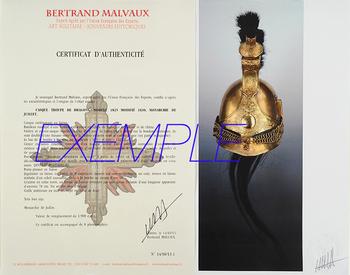
Next update Friday, december 26 at 13:30 PM
FOR ALL PURCHASES, PAYMENT IN MULTIPLE CHECKS POSSIBLE
bertrand.malvaux@wanadoo.fr 06 07 75 74 63
SHIPPING COSTS
Shipping costs are calculated only once per order for one or more items, all shipments are sent via registered mail, as this is the only way to have proof of dispatch and receipt.
For parcels whose value cannot be insured by the Post, shipments are entrusted to DHL or Fedex with real value insured, the service is of high quality but the cost is higher.
RETURN POLICY
Items can be returned within 8 days of receipt. They must be returned by registered mail at the sender's expense, in their original packaging, and in their original condition.
AUTHENTICITY
The selection of items offered on this site allows me to guarantee the authenticity of each piece described here, all items offered are guaranteed to be period and authentic, unless otherwise noted or restricted in the description.
An authenticity certificate of the item including the description published on the site, the period, the sale price, accompanied by one or more color photographs is automatically provided for any item priced over 130 euros. Below this price, each certificate is charged 5 euros.
Only items sold by me are subject to an authenticity certificate, I do not provide any expert reports for items sold by third parties (colleagues or collectors).
FOR ALL PURCHASES, PAYMENT IN MULTIPLE CHECKS POSSIBLE
bertrand.malvaux@wanadoo.fr 06 07 75 74 63
An authenticity certificate of the item including the description published on the site, the period, the sale price, accompanied by one or more color photographs is automatically provided for any item priced over 130 euros. Below this price, each certificate is charged 5 euros.
Only items sold by me are subject to an authenticity certificate, I do not provide any expert reports for items sold by third parties (colleagues or collectors).
